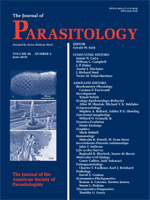Little is known about the importance of capybara, Hydrochoerus hydrochaeris, as reservoirs for parasites of zoonotic or veterinary importance. Sera from 63 capybaras, from 6 counties in the state of São Paulo, Brazil, were examined for antibodies to Trypanosoma cruzi, Leishmania infantum, Encephalitozoon cuniculi, Sarcocystis neurona, and Neospora caninum using an indirect immunofluorescent antibody test. Five (8%) of the 63 capybaras had antibodies to T. cruzi epimastigotes. None of the samples from capybara reacted positively with L. infantum promastigotes or with spores of E. cuniculi. Two (3%) of the serum samples were positive for antibodies to S. neurona merozoites, and 2 (3%) of the serum samples were positive for antibodies to N. caninum tachyzoites. A serum sample from 1 capybara was positive for antibodies to both T. cruzi and N. caninum. None of the remaining 62 samples reacted with more than 1 parasite.
BioOne.org will be down briefly for maintenance on 17 December 2024 between 18:00-22:00 Pacific Time US. We apologize for any inconvenience.
How to translate text using browser tools
1 June 2010
Prevalence of Antibodies to Trypanosoma cruzi, Leishmania infantum, Encephalitozoon cuniculi, Sarcocystis neurona, and Neospora caninum in Capybara, Hydrochoerus hydrochaeris, from São Paulo State, Brazil
Samantha Valadas,
Solange Maria Gennari,
Lucia Eiko Oishi Yai,
Alexa C. Rosypal,
David S. Lindsay
ACCESS THE FULL ARTICLE

Journal of Parasitology
Vol. 96 • No. 3
June 2010
Vol. 96 • No. 3
June 2010




